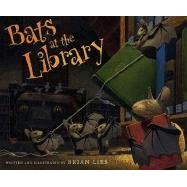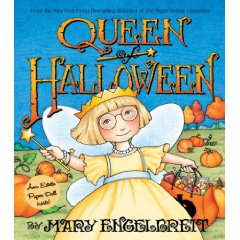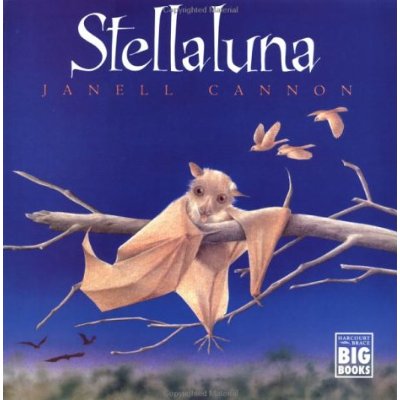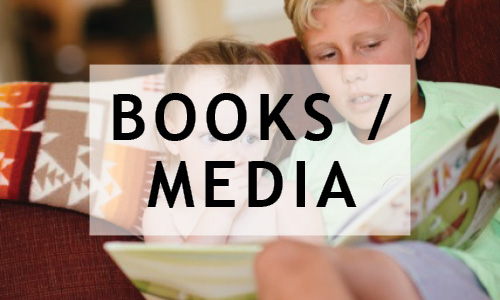Halloween brings on excited anticipation in children as they plan the character they will “be” for the night and search for that perfect costume. I’ve already been privy to a 3 year-old’s Dorothy costume, complete with her basket and Toto. It resides on a high shelf so it won’t be worn out before October 31st.
Why not take advantage of the buzz around Halloween and introduce some new books around the theme that can capture your child’s interest and build his language through rhyme, vocabulary and clever plots to spark conversation.

Bats at the Library, written and illustrated by Brian Lies, flies us through the library’s open window, carelessly left open one night, to the delight of a brood of fun-loving, book-loving bats. During an “inky evening” that is “cool, calm and clear”, the bored bats declare a Bat Night at the Library. Forming wall shadows from the overhead projector, duplicating themselves on the copier, playing house in a pop-up book, swimming in the water fountain, and producing their own story time, these bats know how to love a library. Clever illustrations show the bats dreamily lost in the world of storybooks, imagining themselves in favorites from the past. Finally, as the sun peeks out, the nocturnal capers must come to a halt.
Tips to Build Language and Literacy:
• Emphasize the rhyming words at the end of sentences and then repeat the two words—“All this sameness leaves us blue and makes us ache for something new.” Blue-new. Talk about rhyming words, brainstorming more words that rhyme with “new” or add a rhyming line to the page that relates to the story and picture.
• Point out that the author and illustrator is the same person. Our children are both author and illustrator for their writing work too. Find out a little about him. He loves libraries and visits them whenever her travels to new cities. What are things that your child really likes and would like to write about?
• Repeat the rich vocabulary the author uses in describing his bats’ capers—“We’ve feasted, fluttered, swooped and soared and yet…we’re still a little bored.” Who feasts? Who flutters? Who swoops? Who soars? The pilgrims, a hummingbird, a pelican or an eagle. Brainstorm to think of as many things as you can that move like those verbs. In their story-telling and writing process in school, children are constantly asked to brainstorm ideas. Use that word as you have fun.

Queen of Halloween written and illustrated by Mary Engelbreit, is a simple but poignant story of a fairy venturing out on Halloween night with her friend, the pirate at her side. A perfect book to read to the younger set to prepare them for Halloween, this book deals with the excitement and trepidation of a night walking along dark sidewalks, ringing the neighbor’s doorbells and meeting others in costume who can be frightening. Lots of relevant lessons like “Don’t be scared, it’s just pretend,” “grownups come along trick or treating” and “try to be brave” are illustrated through the story. Engelbreit’s vintage inspired drawings give a warmth to a first outing among goblins and ghosts.
Tips for Building Language and Literacy:
• Use this book as a social story about a first Halloween experience. Walk your child through what happens and prepare them for the fun and fears of Halloween. This would be a good book for children with special needs to help them understand the trick or treating experience before they venture out.
• Talk about feelings. Why is Ann Estelle scared? What should she do? When do you get scared?
• Predict the story’s outcomes. Pause at appropriate places and enjoy predicting with your child. You model a prediction first and make this an enjoyable activity. “I think Ann Estelle is going to go back to her dad and not stay at the dark house’s door. What do you think?” Always praise any predictions. “Great prediction, let’s see what happens.” There is no right answer, the important thing is to be thinking ahead and proposing new endings to situations. This helps kids eventually create options in their own stories that they write.
• Punch out the Ann Estelle puppet at the end and re-enact the story. Let your child be the storyteller. She can add on new episodes.

Stellaluna by Janell Cannon is the endearing story of a baby bat, separated from her mother after an owl attack, landing in a nest of birds. As their friendship grew, each tried to be like the other—Stellaluna, eating bugs from mama bird and the baby birds trying to hang by their feet. Finally, discovered by her bat friends, Stellaluna learned of her differences—her ability to see and fly in the darkness, eat a mango or hang by her feet. Anxious to share these abilities with her friends, she soon discovers that being so different is okay because really they are so much alike!
Tips for Building Language and Literacy:
• Talk about what makes different animals unique. See how many characteristics you and your child can list
• Chose two animals and make a list of what is the “same” and “different.” Make a drawing of each to illustrate your list.
• Think of friends and what makes each one special—Quinn is a fast runner, Brooke is good at drawing, Ryan is fun or Will is patient. Talk about how each friend has special qualities to appreciate.
Other favorites:
Aaaarrgghh! Spider! by Lydia Monks
Big Pumpkin by Erica Silverman




